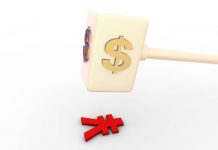US inflation eased to 3%. It’s still not the 2% targeted by the Federal Reserve (Fed), but it’s approaching. Core inflation on the other hand eased more than expected to 4.8%. That’s still more than twice the Fed’s 2% policy target, but again, the US inflation numbers are clearly on the right path, the services inflation including shelter costs is easing, and all this is good news for breaking the Fed hawks back amid mounting tension over the past few weeks.
There hasn’t been much change in the expectation of another 25bp hike at the Fed’s next policy meeting, which is now given a more than 90% chance, but the expectation for a September hike fell, the US 2-year dropped to 4.70% after the CPI data, while the 10-year yield fell to 3.85%.
One big question is: if inflation is easing at a – let’s say – pleasing speed, why would the Fed bother raising the interest rates more? Wouldn’t it be better to just wait and see where inflation is headed?
Well yes, but the Fed officials certainly continue thinking that 4.8% is still too hot, and that the risk of a U-turn in inflation expectations, and inflation is still to be carefully managed. Because the favourable base effect due to energy prices will gently start fading away in the coming months and the result on inflation will be less appetizing. Then the rising energy prices today could fuel price dynamics again in the coming months, and if China manages to fuel growth thanks to ample monetary and fiscal stimulus, the impact on global inflation could be felt. And if you listen to Richmond Fed’s Thomas Barkin, that’s exactly what comes out: ‘if you back off too soon, inflation comes back stronger’. But the possibility of two more rate hikes following the most aggressive hiking cycle from the Fed starts looking a bit stretched with the actual data. Due to release today, the US producer price inflation is expected to have fallen to the lowest levels since the pandemic, we could even see some deflation.
And a potential Chinese boost to inflation looks much less threatening today compared to a couple of months ago. Chinese exports plunged 12.4% in June, worse than a 7.5% drop printed in May and worse than the market forecasts of a 9.5% decline. The June decline in Chinese exports marked the steepest fall in sales since February 2020. Deteriorating foreign demand on the back of high inflation and rising interest rates continued taking a toll on Chinese trade numbers. In the meantime, imports fell 6.8%, the fourth straight month of decrease due to persistently weak domestic demand.
China will likely recover at some point, but we will unlikely see the Chinese growth put a severe pressure on commodity markets. That’s one good news for inflation watchers. The other one is that the US student loan repayments will resume from October, and that should act as a restrictive fiscal action, and help the Fed tame inflation. Therefore, even though there could be an uptick in inflation figures in the coming months, we will unlikely see inflation spike back above 4-5% again. But we will also unlikely to see it fall to 2% easily.
US Dollar plunges
The selloff in the US dollar accelerates post-CPI, with the dollar index approaching the 100 level with big and steady steps. This is good news for inflation in the rest of the world, because the softer the US dollar, the softer the energy and raw material prices negotiated in terms of US dollars. In the same way the dollar appreciation fueled inflation globally, its depreciation could help ease it as well.
The EURUSD spiked to 1.1150, Cable advanced past the 1.30 level, while the dollar-yen extended losses below the 140 psychological mark. In precious metals, gold is thriving on the back of softer yields and the softer dollar. The price of an ounce rallied past $1960 and consolidates near $1955 at the time of writing.
In energy, oil bulls target the 200-DMA, that stands near the $77pb level, yet the $77/80 range will be hard to drill as the higher the energy the prices, the higher the inflation expectations, and the higher the inflation expectations, the tighter the Fed policy. The tighter the Fed policy, the stronger the odds of recession, and the stronger the odds of recession, the softer the global energy demand, and the softer the energy prices.
In equities, soft US inflation and decline in US yields pushed the S&P500 to a fresh high since April 2022. The index flirted with the 4500 level on expectation that the Fed will hike one more time and stop, and that the actual tightening cycle could very well end with a soft landing. Nasdaq 100, on the other hand, rallied to the highest levels since the beginning of last year. Meta for example jumped 3.70% on the back of inflation optimism and the news that its Threads platform is growing while dampening traffic on rival Twitter.
On a side note, because Nasdaq 100 is now over-concentrated in Mega Cap stocks, there will be a rebalancing in the weightings of the index. Nasdaq has a rule stating that the aggregate total of individual weights above 4.5% in the index shouldn’t exceed 48% of the total weighting. And today, the Magnificent Seven is worth around 55% of Nasdaq 100. So, the changing weights could weigh on Nasdaq, as the best performing stocks will see their weight drawn down.













